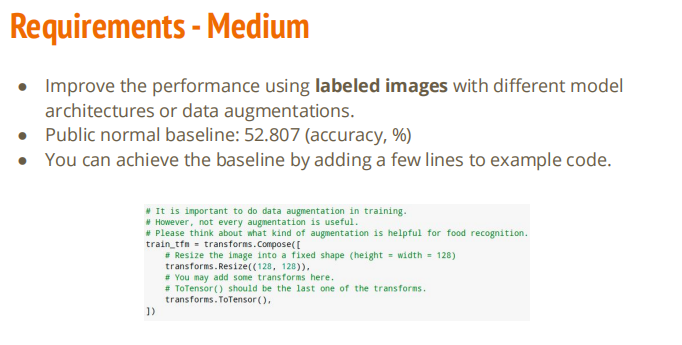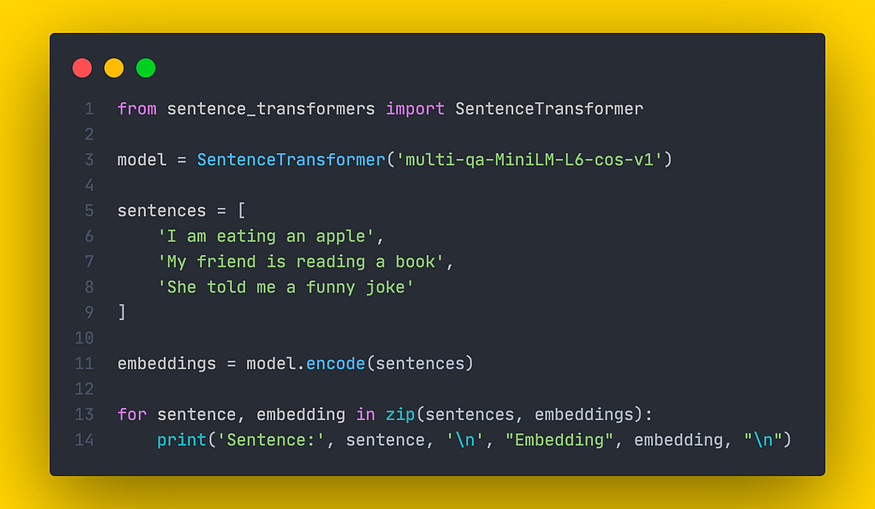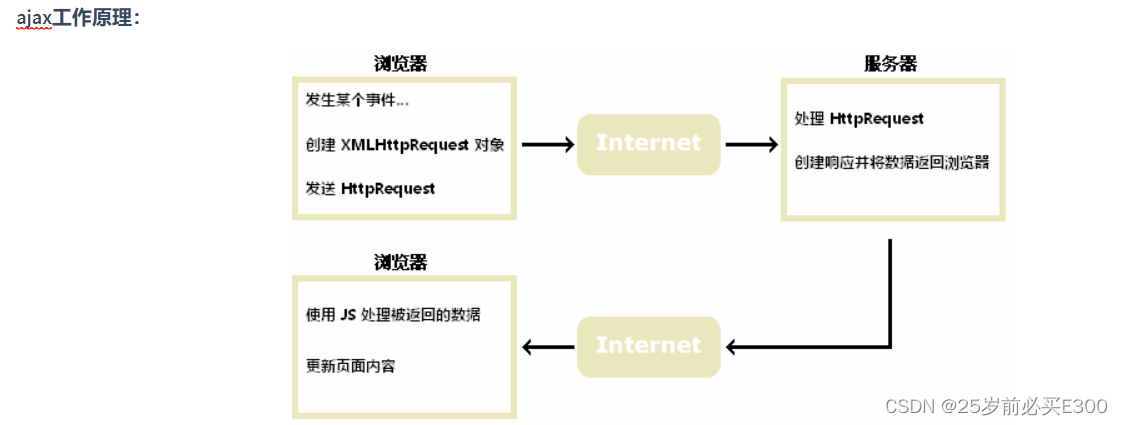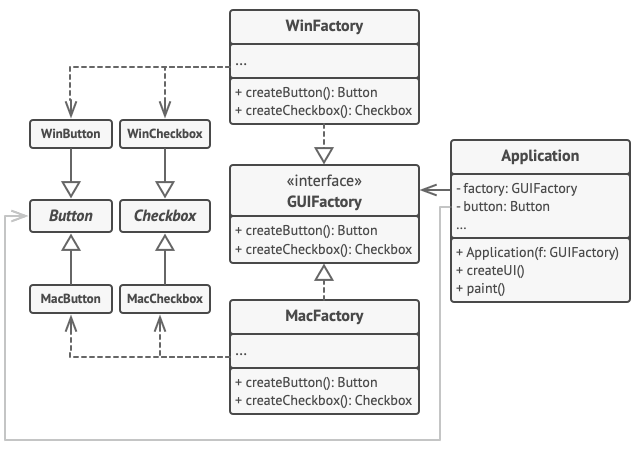
修改模型架构或者进行图像增强
# Normally, We don't need augmentations in testing and validation.
# All we need here is to resize the PIL image and transform it into Tensor.
test_tfm = transforms.Compose([transforms.Resize((128, 128)),transforms.ToTensor(),#transforms.Normalize((0.485, 0.456, 0.406), (0.229, 0.224, 0.225)),
])# However, it is also possible to use augmentation in the testing phase.
# You may use train_tfm to produce a variety of images and then test using ensemble methods
train_tfm = transforms.Compose([# Resize the image into a fixed shape (height = width = 128)#transforms.CenterCrop()transforms.RandomResizedCrop((128, 128), scale=(0.7, 1.0)),#transforms.AutoAugment(transforms.AutoAugmentPolicy.IMAGENET),#transforms.Normalize((0.485, 0.456, 0.406), (0.229, 0.224, 0.225)),transforms.RandomHorizontalFlip(0.5),transforms.RandomVerticalFlip(0.5),transforms.RandomRotation(180),transforms.RandomAffine(30),#transforms.RandomInvert(p=0.2),#transforms.RandomPosterize(bits=2),#transforms.RandomSolarize(threshold=192.0, p=0.2),#transforms.RandomEqualize(p=0.2),transforms.RandomGrayscale(p=0.2),transforms.ToTensor(),#transforms.RandomApply(torch.nn.ModuleList([]))# You may add some transforms here.# ToTensor() should be the last one of the transforms.
])
修改模型架构, 建立 resudial
class Residual_Block(nn.Module):def __init__(self, ic, oc, stride=1):# torch.nn.Conv2d(in_channels, out_channels, kernel_size, stride, padding)# torch.nn.MaxPool2d(kernel_size, stride, padding)super().__init__()self.conv1 = nn.Sequential(nn.Conv2d(ic, oc, kernel_size=3, stride=stride, padding=1),nn.BatchNorm2d(oc),nn.ReLU(inplace=True))self.conv2 = nn.Sequential(nn.Conv2d(oc, oc, kernel_size=3, stride=1, padding=1),nn.BatchNorm2d(oc),)self.relu = nn.ReLU(inplace=True)self.downsample = Noneif stride != 1 or (ic != oc):self.downsample = nn.Sequential(nn.Conv2d(ic, oc, kernel_size=1, stride=stride),nn.BatchNorm2d(oc),)def forward(self, x):residual = xout = self.conv1(x)out = self.conv2(out)if self.downsample:residual = self.downsample(x)out += residualreturn self.relu(out)class Classifier(nn.Module):def __init__(self, block, num_layers, num_classes=11):super().__init__()self.preconv = nn.Sequential(nn.Conv2d(3, 32, kernel_size=7, stride=2, padding=3, bias=False),nn.BatchNorm2d(32),nn.ReLU(inplace=True),)self.layer0 = self.make_residual(block, 32, 64, num_layers[0], stride=2)self.layer1 = self.make_residual(block, 64, 128, num_layers[1], stride=2)self.layer2 = self.make_residual(block, 128, 256, num_layers[2], stride=2)self.layer3 = self.make_residual(block, 256, 512, num_layers[3], stride=2)#self.avgpool = nn.AvgPool2d(2)self.fc = nn.Sequential( nn.Dropout(0.4),nn.Linear(512*4*4, 512),nn.BatchNorm1d(512),nn.ReLU(inplace=True),nn.Dropout(0.2),nn.Linear(512, 11),)def make_residual(self, block, ic, oc, num_layer, stride=1):layers = []layers.append(block(ic, oc, stride))for i in range(1, num_layer):layers.append(block(oc, oc))return nn.Sequential(*layers)def forward(self, x):# [3, 128, 128]out = self.preconv(x) # [32, 64, 64]out = self.layer0(out) # [64, 32, 32]out = self.layer1(out) # [128, 16, 16]out = self.layer2(out) # [256, 8, 8]out = self.layer3(out) # [512, 4, 4]#out = self.avgpool(out) # [512, 2, 2]out = self.fc(out.view(out.size(0), -1)) return out
修改损失函数,使用Focalloss
import torch.nn.functional as F
from torch.autograd import Variableclass FocalLoss(nn.Module):def __init__(self, class_num, alpha=None, gamma=2, size_average=True):super().__init__()if alpha is None:self.alpha = Variable(torch.ones(class_num, 1))else:if isinstance(alpha, Variable):self.alpha = alphaelse:self.alpha = Variable(alpha)self.gamma = gammaself.class_num = class_numself.size_average = size_averagedef forward(self, inputs, targets):N = inputs.size(0)C = inputs.size(1)P = F.softmax(inputs, dim=1)class_mask = inputs.data.new(N, C).fill_(0)class_mask = Variable(class_mask)ids = targets.view(-1, 1)class_mask.scatter_(1, ids.data, 1.)if inputs.is_cuda and not self.alpha.is_cuda:self.alpha = self.alpha.cuda()alpha = self.alpha[ids.data.view(-1)]probs = (P*class_mask).sum(1).view(-1, 1)log_p = probs.log()batch_loss = -alpha*(torch.pow((1-probs), self.gamma))*log_pif self.size_average:loss = batch_loss.mean()else:loss = batch_loss.sum()return lossclass MyCrossEntropy(nn.Module):def __init__(self, class_num):pass
K 折交叉验证
k_fold = 4
num = len(total_files) // k_fold
# "cuda" only when GPUs are available.
device = "cuda" if torch.cuda.is_available() else "cpu"
print(device)# The number of training epochs and patience.# Initialize a model, and put it on the device specified.#from torchsummary import summary
#summary(model, (3, 128, 128))
# For the classification task, we use cross-entropy as the measurement of performance.
#criterion = nn.CrossEntropyLoss()# Initialize optimizer, you may fine-tune some hyperparameters such as learning rate on your own.# Initialize trackers, these are not parameters and should not be changedtest_fold = k_foldfor i in range(test_fold):fold = i+1print(f'\n\nStarting Fold: {fold} ********************************************')model = Classifier(Residual_Block, num_layers).to(device)criterion = FocalLoss(11, alpha=alpha)optimizer = torch.optim.Adam(model.parameters(), lr=0.0004, weight_decay=2e-5) scheduler = torch.optim.lr_scheduler.CosineAnnealingWarmRestarts(optimizer, T_0=16, T_mult=1)stale = 0best_acc = 0val_data = total_files[i*num: (i+1)*num]train_data = total_files[:i*num] + total_files[(i+1)*num:]train_set = FoodDataset(tfm=train_tfm, files=train_data)train_loader = DataLoader(train_set, batch_size=batch_size, shuffle=True, num_workers=0, pin_memory=True)valid_set = FoodDataset(tfm=test_tfm, files=val_data)valid_loader = DataLoader(valid_set, batch_size=batch_size, shuffle=True, num_workers=0, pin_memory=True)for epoch in range(n_epochs):# ---------- Training ----------# Make sure the model is in train mode before training.model.train()# These are used to record information in training.train_loss = []train_accs = []lr = optimizer.param_groups[0]["lr"]pbar = tqdm(train_loader)pbar.set_description(f'T: {epoch+1:03d}/{n_epochs:03d}')for batch in pbar:# A batch consists of image data and corresponding labels.imgs, labels = batch#imgs = imgs.half()#print(imgs.shape,labels.shape)# Forward the data. (Make sure data and model are on the same device.)logits = model(imgs.to(device))# Calculate the cross-entropy loss.# We don't need to apply softmax before computing cross-entropy as it is done automatically.loss = criterion(logits, labels.to(device))# Gradients stored in the parameters in the previous step should be cleared out first.optimizer.zero_grad()# Compute the gradients for parameters.loss.backward()# Clip the gradient norms for stable training.grad_norm = nn.utils.clip_grad_norm_(model.parameters(), max_norm=10)# Update the parameters with computed gradients.optimizer.step()# Compute the accuracy for current batch.acc = (logits.argmax(dim=-1) == labels.to(device)).float().mean()# Record the loss and accuracy.train_loss.append(loss.item())train_accs.append(acc)pbar.set_postfix({'lr':lr, 'b_loss':loss.item(), 'b_acc':acc.item(),'loss':sum(train_loss)/len(train_loss), 'acc': sum(train_accs).item()/len(train_accs)})scheduler.step()# Make sure the model is in eval mode so that some modules like dropout are disabled and work normally.model.eval()# These are used to record information in validation.valid_loss = []valid_accs = []# Iterate the validation set by batches.pbar = tqdm(valid_loader)pbar.set_description(f'V: {epoch+1:03d}/{n_epochs:03d}')for batch in pbar:# A batch consists of image data and corresponding labels.imgs, labels = batch#imgs = imgs.half()# We don't need gradient in validation.# Using torch.no_grad() accelerates the forward process.with torch.no_grad():logits = model(imgs.to(device))# We can still compute the loss (but not the gradient).loss = criterion(logits, labels.to(device))# Compute the accuracy for current batch.acc = (logits.argmax(dim=-1) == labels.to(device)).float().mean()# Record the loss and accuracy.valid_loss.append(loss.item())valid_accs.append(acc)pbar.set_postfix({'v_loss':sum(valid_loss)/len(valid_loss), 'v_acc': sum(valid_accs).item()/len(valid_accs)})#break# The average loss and accuracy for entire validation set is the average of the recorded values.valid_loss = sum(valid_loss) / len(valid_loss)valid_acc = sum(valid_accs) / len(valid_accs)if valid_acc > best_acc:print(f"Best model found at fold {fold} epoch {epoch+1}, acc={valid_acc:.5f}, saving model")torch.save(model.state_dict(), f"Fold_{fold}_best.ckpt")# only save best to prevent output memory exceed errorbest_acc = valid_accstale = 0else:stale += 1if stale > patience:print(f"No improvment {patience} consecutive epochs, early stopping")break


















